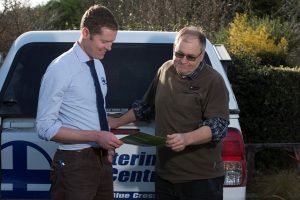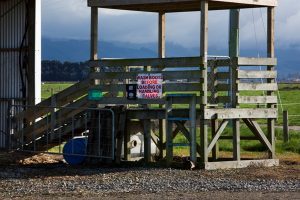The arrival of Mycoplasma bovis has highlighted the need for good biosecurity measures across the country. Anne Lee reports.
Biosecurity begins at home, right at the farm gate and the boundary fence – it’s not just about security at the country’s borders.
It’s one of the big lessons farmers around the country are learning quickly following the detection of Mycoplasma bovis and, while nationally many are just coming to grips with what that might mean, South Canterbury farmers and vets have been dealing with it for almost a year now.
Morven dairy farmer Hugh Le Fleming and Oamaru vet Andrew Muir from the Veterinary Centre told a South Island Dairy Event (SIDE) workshop in Dunedin last month that good biosecurity at a farm level can prevent infection entering your farm, help slow the spread of disease, or even increase the likelihood of successful eradication, when diseases or pests find their way into the country.
The recent M bovis incursion has driven that message home hard, they said, and lifting the profile of biosecurity onfarm for many diseases and pests was well overdue.
‘You’re going to try and avoid animals getting out of course but you need to have that conversation with neighbours – is there a quarantine paddock an animal can be put into it, where should it be, what’s the procedure?’
But it’s also brought home that biosecurity is important to the whole country and that it’s a community responsibility where people, whether in town or the country, all need to support each other.
“The blame game isn’t going to solve this. We are a small population living on islands in the South Pacific and our lifestyles and our families are totally dependent on one another in this,” Hugh said.

The M bovis experience has been devastating for many and created enormous stress and heartache.
“We can beat this though and we’ve got to put that Kiwi can-do attitude to work,” he said.
It’s essential that farmers take time to assess their own farming operations with a particular eye to biosecurity because every farm has its own quirks in terms of layout and location, every farming system is different and the degree to which animals, people and equipment come and go vary.
“We can give you the main areas to look at and some practical actions to take but to have an effective biosecurity plan for your farm you are going to have to look closely at your particular situation,” Andrew said.
“It’s not something you’ll deal with in one hit, it’s a new way of thinking but when you switch your mindset to it, the solutions you’ll find as farmers will be obvious and are often quite simple.

“Some, though, are more difficult than others and rely on other people carrying out what’s needed but stand firm and show you’re serious that those actions are followed,” Hugh said.
While they agreed National Animal Identification and Tracing (NAIT) had its issues and it was its own subject in itself they implored farmers to use it every time stock were moved.
To help farmers draw up their own biosecurity action plan Andrew said the Farm Biosecurity Action Plan developed by the Morven Action Group farmers, including Hugh, in conjunction with local vets from the Veterinary Centre and Vet Life has a range of good practical ideas.
With that as a basis, farmers should consider the three main areas of risk for their individualised plans:
Animals, People, Equipment
Animals
“Think in, out and over when you’re thinking about animal risks.
“Animals coming into the farm – bulls, any replacement cows or young stock bought in – they pose the greatest risk when it comes to disease.
“Animals going out – young stock or cows going off-farm to grazing or wintering, what do you do while they’re away to make sure they’re not exposed to disease and then bring it back on to your farm?
“Animals going over – that’s about boundary fencing – nose-to-nose contact or animals jumping fences,” Andrew said.
“Having power on both sides of the fence is double protection because if there’s a problem on one side there’s a backup on the other,” Hugh said.
“But make sure staff have guaranteed access to a tester and they’re testing those boundary fences regularly.”
Consider a back-up generator so you can milk through a major power outage – walking cows to other farms and putting them through other people’s dairies poses a disease risk.

Neighbours need to communicate about how they manage boundaries and have a plan for what to do with any animals that did get out onto the road.
“You’re going to try and avoid animals getting out of course but you need to have that conversation with neighbours – is there a quarantine paddock an animal can be put into it, where should it be, what’s the procedure?” Hugh said.
One Morven farm was infected when an animal that had got out on to the roadside was wrongly put into a neighbour’s paddock. The farmer’s herd of extremely well-bred cows has now been destroyed.
Hugh has drawn up a farm map and after considerable effort has managed to get cell phone contact details for each of the properties on his boundary.
“That’s going to be put up in the shed but it’s going to have to be updated regularly.”
Good hygiene when dealing with dead stock, placentas or slipped calves was important.
“Don’t just throw the cleanings over the fence – put it in a drum and then manage the offal hole well. Don’t drag dead animals along the ground. It really is a mind-set thing,” Hugh said.
“Some things we’ve done in the past just shouldn’t be done anymore. If you have a cow slip its calf through the winter don’t milk it on someone else’s property,” Andrew said.
When animals come back on to the farm keep them separated from the rest of the herd for a minimum of seven days and monitor them closely for any signs of disease.
“If you don’t have to introduce another animal into your farming business, then don’t. If that means milking 10 less cows, then milk 10 less cows.
“Think about having a no-bull plan but prepare for that now. Let your breeding company area managers know now so they can gear up for that,” Hugh said.
People
Staff, contractors, relief staff, calf-rearers and any visitor to the farm can unwittingly bring disease with them.
Andrew said have one point of entry on the farm which you control. Consider locking other gates with a combination lock.
Station a boot wash and disinfection point at the gate and again at the farm dairy with clear signage so people can wash boots and personal protection equipment as they enter and leave the property.
“For some diseases the chance of spreading the disease on footwear or vehicles might be low but for others it can be a factor. Having the disinfection points and signage focuses people’s attention and shows you are serious,” he said.
There are a number of disinfectants which are effective for varying amounts of time. Read and follow the instructions.
If you have staff moving between blocks or casual staff make sure they clean their boots and clothing and consider providing them with a set that stays on the farm.
Calf pens should be no-go areas for anyone but the calf-rearers who also need to take care not to spread disease from one pen to another.
Put calves being sold at four days into a separate area for people to collect.
Equipment
Take time to think about all the equipment that comes on to the farm and if it doesn’t need to be coming on, stop it.
Contractor equipment, effluent spreaders, vehicles including fertiliser spreaders, animal equipment such as stomach pumps or calf-pullers can all bring disease and all have a different level of risk.
“Insist that vehicles coming on to the property are cleaned. That’s imperative for any vehicles that must go on to areas where animals also go,” Andrew said.
“You need to provide them with somewhere to wash their vehicle down too. A gorse sprayer can quickly be converted into a washdown unit if a hose can’t be set up but again it’s about communicating that to contractors – make sure they use it,” Hugh said.
Equipment used with stock such as stomach pumps or calving jacks could be purchased so they stay on farm.
Don’t allow effluent or waste milk from other farms to come on to your property at all.
Effluent spreaders need to be thoroughly cleaned out between properties. Look at how well equipment can be cleaned and avoid it if you have doubts.
“Be very clear with transport operators and contractors about your expectations. Don’t be afraid to turn people away,” Hugh said.
Consider disinfecting areas of trucks where nasal and oral secretions from other animals are likely before you put your own stock on.
If you share yards or equipment with other farms think about whether you actually need to do that and if you do then have a stand down period of at least 24 hours.
Some diseases such as BVD may require stand down periods of up to seven days.
Bio protection zones
Designate bio-protection zones on the farm map and display it where visitors would sign in.
Green Zone
- Area where no stock can enter.
- Treated as a public zone.
- May include: tanker tracks, tracks to the cattle yards, house driveways.
Blue Zone
- Intermediary areas for incoming stock, suspicious animals, placement of foreign animals, cows for pet food pick up, quarantine.
- Does not have to be a large area of land.
Red Zone
- Areas where stock graze or effluent has been spread.
- No visitor or machinery access, unless they have followed biosecurity procedures (cleaning and disinfection).
Download the Morven Action Group Biosecurity Action Plan





